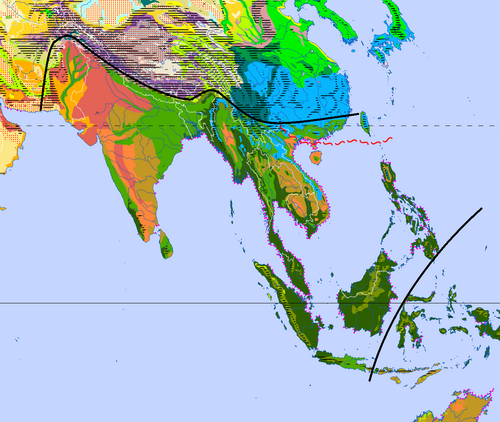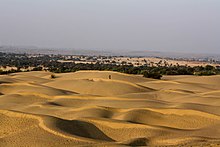Orientalis
The Orientalis ( Latin for east ) or oriental region represents one of the great fauna regions of the world. It essentially comprises southeast Asia, south of the Himalayas .
definition
The region essentially covers the south of Asia and is delimited in the north by the Himalayas in the south-east by the Wallace Line , which was named in honor of Alfred Russel Wallace . In the Pleistocene , when the sea level was lower, the areas northwest of the Wallace Line were connected to the mainland, which explains the similarity of the fauna. Occasionally the eastern Philippines , which apparently were only partially connected to the mainland, are not counted as part of the oriental region. In the west and east there are large transition areas to the Palearctic region, but fauna elements from both regions also permeate in the Himalayan region. In the far west, the Near East deserts form a kind of filter barrier to the Afrotropic region , a border that was not always as effective in the past as it is today. These two regions share numerous animal forms and are sometimes combined to form the palaeotropic islands .
The oriental region is rich in species, but has relatively few independent animal species and shares many forms with the Palearctic, the Afrotropic and the Australis . Among the few endemic groups of mammals are at inclusion of the eastern Philippines, the gymnure that tree shrews , the fur Flitter , the Borken rats , the nose rats , the red pandas , the platacanthomyidae that tarsiers and the Gibbons . The only endemic bird families are the fairy birds and the tree swifts .
Habitats
The two most important vegetation zones are, on the one hand, the dry forests, savannas and thorn bush steppes of India and rear India and, on the other hand, the tropical rain, mountain, swamp and monsoon forests of the Western Ghats and Southeast Asia. Most of the islands, including the large Sunda Islands and the Philippines, which are mostly counted as part of the oriental region, are dominated by rainforests. In Sri Lanka and Java you can find savannahs and rainforests alike. The alluvial plains in the north of the Indian subcontinent are dominated by humid grasslands and forests. The arid desert and semi-desert areas of the Thar can be found in the far west of the oriental region .

|
| Evergreen boreal coniferous forest | Winter-cold semi-deserts | Dry savannahs |
| Cold desert | Mountain coniferous forests | Winter cold deserts | Dornstrauch- u. Cactus savannas |
| Lichen u. Moostundra | Temperate coastal rainforests | Hard foliage vegetation | Tropical dry forests |
| Dwarf shrub u. Meadow tundra | Foliage and Mixed coniferous forests | Hot semi-deserts | Rain-green moist savannahs |
| Mountain tundra, alpine mats, etc. Heathens | Moderate foliage and Floodplain forests | Hot deserts | Trop. u. ʅ Subtropical. Rain green wet forests |
| Hardwood forest tundra u. boreal floodplains | Mixed forest steppes | Highland steppes u. -deserts | Trop. u. ʅ Subtropical. rainforests |
| Softwood forest tundra | Grass steppes u. Salt marshes | Subtropical dry forests | Tropical mountain rainforests & mountains Cloud forests |
| Deciduous boreal coniferous forest | Shrub u. Dry steppes | Subtropical wet forests | Reed swamps u. flooding aquatic plants |
| ≡ = mountain ranges | ::: = desert regions without vegetation | : ¤ : = oasis vegetation (partly with delimitation) | ... = mangrove coasts |


Mammals
Deer, wild cattle, wild boars, elephants, small cats, crawling cats , mongooses , macaques and slender monkeys are distributed over almost the entire region . Large predators such as the tiger and leopard and the red dog are also common in most areas of the region. The typical mammals of the rainforests are clouded leopards , sun bears, gibbons, pointed squirrels and tarsier. Black-backed tapir , Sumatran rhinoceros and Java rhinoceros were once widespread, but these species are now restricted to a few retreat areas. The orangutan is now restricted to the great Sunda islands of Sumatra and Borneo, but was widespread as far as China in the Pleistocene. The Philippines are home to their own, but significantly reduced, large animal world. Tamaraus , pustule pigs and deer live here , but no predators.
Typical mammals of the Indian dry forests and savannahs are wolves, axis deer , hyenas and antelopes such as the Nilgau antelope , the four-horned antelope and the stag goat antelope . The lion was once the most important predator of the savannah, but is now restricted to a protected area, the Gir National Park . The fauna of the alluvial plains in the north is composed of species from the neighboring rainforests and savannas. There are also typical species such as the Indian rhinoceros , the dwarf wild boar and the swamp deer . The deserts in the northwest are home to half-donkeys, gazelles and wolves. The cheetah is no longer found in the Oriental region today, but is restricted to Iran in Asia. The rivers of the region are home to various river dolphins, such as the platanista species and the Chinese river dolphin .
Birds
The orientalis is characterized by a wide range of soil birds, including pheasants , Blue Peacock , megapodes , tragopans , Bankivahühner , snowcock , Argus pheasants , collar Frankoline and arborophila . There are also numerous parrots and birds of prey, such as the Gray-headed eagle , the monkey eagle , the Nepal Hawk-Eagle , the Einfarbhaubenadler and the Black Eagle .
Reptiles
The largest reptiles include the marsh crocodile , the Ganges gavial and the estuarine crocodile .
literature
- J. Illies (1972): Animal Geography. 2nd improved edition, (Edwin Fels, Ernst Weigt and Herbert Wilhelmy; original version: 1970). Georg Westermann Verlag, Braunschweig, ISBN 3-14-160285-9
- J. Mosterín (1977): Fauna. The great book on animal life. Volume 7. South Asia (Oriental Region). Grammont; 1st edition, ISBN 2-8270-0869-6





